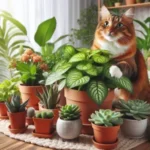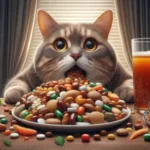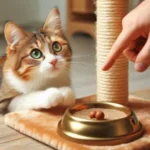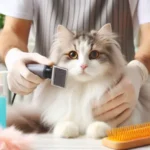As cat owners, we often focus on providing our furry companions with gourmet food, cozy beds, and endless love, but one crucial aspect of their health can sometimes take a backseat: hydration.
Proper water intake is vital for your cat’s overall well-being, affecting everything from their kidney function to their energy levels and skin health. Yet, many cat owners are left wondering—how much water does their feline friend really need? In this comprehensive guide, we will delve into the importance of hydration for cats, explore how to ensure they’re drinking enough, and share practical tips to make water more appealing to even the pickiest of drinkers. Whether you have a playful kitten or a wise old companion, understanding your cat’s hydration needs is key to helping them lead a happy, healthy life. Join us as we uncover the secrets to keeping your beloved pet refreshed and thriving!
1. Introduction: Why Hydration Matters for Cats

Hydration is a fundamental aspect of your cat’s health, yet it’s often overlooked in the hustle and bustle of daily life. Just like humans, cats rely on water to maintain essential bodily functions, from regulating body temperature to aiding digestion and supporting kidney function. Despite their reputation for being low-maintenance pets, cats have specific hydration needs that can be easily missed, especially since they often don’t drink water as readily as other animals.
Cats are naturally evolved to thrive on a diet rich in moisture, primarily from their prey. In the wild, they obtain most of their hydration from the animals they catch, which is why many cats tend to be less inclined to drink from a bowl. However, with the domestication of our feline friends and their shift towards dry kibble diets, the need for adequate water intake has become a pressing concern. Dehydration can lead to serious health issues, including urinary tract problems, kidney disease, and even life-threatening conditions.
Understanding why hydration matters for cats is crucial for any cat owner who wants to ensure their furry companion lives a long, healthy life. In this guide, we will delve into the importance of hydration, how to recognize signs of dehydration, and practical tips for encouraging your cat to drink more water. By prioritizing hydration, not only will you support your cat’s overall well-being, but you’ll also foster a stronger bond as you become more attuned to their needs. Let’s embark on this journey to keep your feline friend happy, healthy, and hydrated!
2. Understanding Your Cat’s Water Needs
To ensure your feline friend stays healthy and happy, it’s crucial to understand their unique water needs. Cats, being descendants of desert-dwelling ancestors, have evolved to be efficient at conserving water, but this doesn’t mean they don’t require adequate hydration. In fact, knowing how much water your cat needs can help prevent serious health issues, including urinary tract problems and kidney disease.
The general rule of thumb is that cats should consume about 2.5 to 4.5 ounces of water per five pounds of body weight each day. However, this can vary based on several factors, including age, diet, activity level, and environmental conditions. For instance, if your cat primarily eats dry food, they will need to drink more water, as dry kibble contains significantly less moisture than wet food. Conversely, if your cat enjoys a wet food diet, their water intake may decrease since these meals already contain a substantial amount of moisture.
Additionally, keep in mind that certain life stages or medical conditions may also affect your cat’s hydration needs. Kittens, for example, require more water relative to their size because they are growing rapidly. Senior cats or those with health issues, such as diabetes or hyperthyroidism, may also need additional water to support their overall health.
To monitor your cat’s hydration, observe their drinking habits and overall behavior. Signs of dehydration can include dry gums, lethargy, and a lack of skin elasticity. By understanding your cat’s specific water needs and adjusting accordingly, you’ll be well on your way to ensuring your furry companion remains properly hydrated and thriving.
3. Signs of Dehydration in Cats

Understanding the signs of dehydration in cats is crucial for maintaining their health and well-being. Unlike dogs, who may visibly pant or appear lethargic, cats can be more subtle in their signs, making it essential for pet owners to remain vigilant. One of the first indicators of dehydration is a change in skin elasticity. Gently pinch the skin between your cat’s shoulder blades; if it doesn’t snap back quickly, this may suggest dehydration.
Another telltale sign is the condition of their gums. Healthy gums should be a moist, pale pink. If they appear dry or tacky, or if the color has darkened to a deep red, it’s a red flag that your feline friend may not be getting enough fluids. Additionally, consider their overall behavior—if your cat seems unusually lethargic, is sleeping more than usual, or has lost interest in playtime, it could be a sign that they are feeling unwell.
Monitor your cat’s drinking habits as well; a decrease in water intake or changes in urination patterns can signal a problem. If you notice that they are not visiting the litter box as frequently or if the urine is darker than usual, these are crucial signs to pay attention to.
In more severe cases, dehydration can lead to critical health issues, such as kidney problems, so it’s vital to act quickly if you suspect your cat is dehydrated. Regular check-ins with your vet, along with monitoring these signs, can help you keep your feline companion happy and hydrated. By being proactive and aware of these signs, you can ensure your cat stays healthy and well-hydrated for years to come.
4. The Importance of Age and Activity Level
When it comes to keeping your feline friend properly hydrated, their age and activity level play crucial roles in determining their water needs. Kittens, with their boundless energy and playful antics, typically require more water than adults due to their rapid growth and high metabolism. As they explore their surroundings and engage in energetic play, they lose moisture through both physical activity and the natural processes of their bodies. Young cats, particularly those in the prime of their playful years, can benefit from increased hydration to support their development and energy levels.
On the other hand, senior cats present a different set of hydration challenges. As cats age, their bodies become less efficient at conserving water, and they may also experience a diminished sense of thirst. This can lead to chronic dehydration if not addressed. Older cats may be less active, spending more time lounging than roaming, which can also contribute to reduced fluid intake. Therefore, it’s vital for caregivers to monitor their senior cats closely and encourage hydration through enticing methods—like offering fresh water in multiple locations or incorporating wet food into their diet.
Additionally, a cat’s activity level can fluctuate based on various factors such as environmental stimulation, health conditions, or changes in routine. An active cat may engage in more vigorous play or outdoor exploration, necessitating an increase in water consumption to replenish lost fluids. Conversely, a more sedentary cat may require less water, but it’s essential to ensure that it still receives adequate hydration to maintain overall health.
Overall, understanding your cat’s unique needs based on age and activity level will empower you to provide the right amount of water, helping to keep them healthy, happy, and hydrated throughout their lives. Whether you have a playful kitten or a wise old companion, staying attuned to their hydration needs is a vital aspect of responsible pet care.
5. How Diet Affects Hydration: Dry vs. Wet Food

When it comes to keeping your cat hydrated, understanding the impact of their diet is essential. The debate between dry and wet food is a long-standing one among pet owners, but it plays a crucial role in your cat’s overall hydration levels.
Cats that primarily consume dry food may not be getting enough moisture in their diet. Dry kibble typically contains about 10% moisture, meaning that a cat feeding solely on this type of food might end up drinking less water than they actually need. Since felines are instinctively designed to derive hydration from their prey—primarily composed of water-rich tissues—dry food alone can leave them at risk of dehydration.
On the other hand, wet food presents a delicious solution. With a moisture content ranging from 70% to 80%, canned or wet food not only satisfies your cat’s taste buds but also significantly contributes to their daily water intake. Incorporating wet food into their meals can provide a substantial hydration boost, especially for cats that are reluctant drinkers or those prone to urinary tract issues.
It’s essential to consider your cat’s individual preferences and health needs when deciding on their diet. Some cats thrive on a mixed diet of both dry and wet food, allowing them to benefit from the texture and crunch of kibble while still enjoying the hydration offered by canned food. Moreover, ensuring access to fresh water at all times is vital, regardless of their primary food choice.
In summary, the type of food you offer your feline companion plays a significant role in their hydration. By understanding the differences between dry and wet food, you can make informed choices that support your cat’s health and well-being, keeping them happy, hydrated, and purring away.
6. Recommended Daily Water Intake for Cats
Understanding the recommended daily water intake for cats is crucial for ensuring their overall health and well-being. While the exact amount can vary depending on several factors, including age, diet, activity level, and environmental conditions, a general guideline can help provide a benchmark.
On average, a healthy adult cat should consume about 3.5 to 4.5 ounces of water per 5 pounds of body weight each day. This means that a standard 10-pound cat should drink approximately 7 to 9 ounces of water daily. Keep in mind that this is just a baseline; some cats may require more, especially if they are particularly active or live in a warmer climate.
It’s also important to consider the cat’s diet when determining their water needs. Cats who primarily eat dry kibble will naturally need more water than those on a wet food diet, as canned food typically contains about 70-80% moisture. A cat consuming a diet rich in wet food may require less supplemental water, but it’s still essential to ensure they have constant access to fresh, clean water.
Monitoring your cat’s drinking habits is equally important. If you notice significant changes in their water intake—whether a decrease or an increase—it could be a sign of underlying health issues, such as kidney disease or diabetes. Keeping an eye on their hydration levels can help catch potential problems early.
Additionally, offering multiple water sources throughout your home can encourage your feline friend to drink more. Consider placing water bowls in different locations, or even investing in a pet water fountain, as many cats are attracted to running water. By understanding and catering to your cat’s hydration needs, you can promote better health and longevity for your beloved companion.
7. Creative Ways to Encourage Drinking

Keeping your cat hydrated can sometimes feel like a Herculean task, especially if your feline friend is more inclined to turn up their nose at their water bowl than take a refreshing sip. However, there are a number of creative strategies you can employ to encourage your cat to drink more water, making hydration an enjoyable experience rather than a chore.
**1. Offer Variety**: Cats can be quite finicky, so varying the type of water you provide can pique their interest. Try offering filtered water, spring water, or even ice cubes made from low-sodium chicken broth. Some cats are more inclined to drink from a bowl that has a different texture or material—ceramic, stainless steel, or glass can each provide a unique experience.
**2. Water Fountains**: Cats are instinctively attracted to running water, which is why a pet water fountain can be a game changer. The sound of flowing water can entice your cat to drink more frequently, and many models filter the water, keeping it fresher and cooler than still water in a bowl.
**3. flavor Enhancers**: Sometimes, all it takes to get your cat to drink more is a bit of flavor. There are commercial water additives designed specifically for pets that can add a hint of taste without being harmful. Alternatively, you can mix small amounts of broth into their water or use pet-safe flavoring to make it more appealing.
**4. Wet Food Wonders**: Incorporating wet food into your cat’s diet is an excellent way to boost their overall fluid intake. Many cats love the texture and taste of wet food, which contains significantly more moisture than dry kibble. You can even make homemade meals with added broth or pureed veggies to keep things exciting!
**5. Create a Thirst-Quenching Environment**: Place multiple water bowls around your home, ideally in areas where your cat spends the most time. Cats can be territorial and may prefer to drink from a bowl that’s away from their food. You might also want to experiment with placing bowls at varying heights—some cats prefer drinking from elevated surfaces.
**6. Playful Engagement**: Engage your cat in play that involves water, such as using a toy or lure that they can chase into a shallow dish of water. This playful interaction not only motivates your cat to drink but also keeps their instinctual hunting behaviors sharp.
**7. Routine and Reminders**: Lastly, establishing a routine can create a habit. Schedule specific times during the day to encourage your cat to drink, perhaps after playtime or meals. You can also gently guide them to their water bowl by tapping it or using treats to lead them over.
By incorporating these creative methods into your cat care routine, you can help ensure that your feline friend stays well-hydrated, promoting their overall health and happiness. Remember, every cat is unique, so experiment with different approaches until you find what works best for your purring companion!
8. The Benefits of Cat Water Fountains
When it comes to keeping your cat hydrated, one of the most effective and enjoyable solutions is the use of cat water fountains. These innovative devices not only encourage your feline friend to drink more water, but they also offer a myriad of benefits that traditional water bowls simply can’t match.
First and foremost, cat water fountains provide a continuous flow of fresh, filtered water. Cats are instinctually drawn to moving water, as it mimics the natural streams and rivers they would encounter in the wild. This dynamic movement encourages them to drink more often, helping to prevent dehydration, urinary tract issues, and kidney problems—common ailments in our furry companions.
Moreover, many cat water fountains come equipped with filters that remove impurities, odors, and debris, ensuring that your pet always has access to clean water. This not only enhances the taste but also keeps the water free from bacteria that can develop in stagnant bowls.
The design of these fountains also plays a role in their appeal. With various styles and heights available, you can find a fountain that suits your cat’s preferences and fits seamlessly into your home décor. Some fountains even feature multiple drinking streams or tiers, allowing for a more engaging experience as your cat can choose how and where to drink.
Additionally, cat water fountains can be a boon for pet owners who are often on the go. With these devices, you can rest assured that your cat has access to water even when you’re not around to refill a bowl. Many models hold a significant amount of water, reducing the frequency of refills and ensuring that your pet remains hydrated throughout the day.
Incorporating a cat water fountain into your pet care routine is a simple yet impactful way to promote better hydration. With the enticing movement of water, enhanced cleanliness, and engaging designs, these fountains can transform the mundane act of drinking into a delightful experience for your feline friend. By making hydration fun and accessible, you’ll not only support your cat’s health but also foster a happier, more active lifestyle.
9. Choosing the Right Water Bowl for Your Cat
Choosing the right water bowl for your cat might seem like a trivial task, but it can significantly impact their hydration habits. Cats are notoriously particular creatures, and their preferences can be surprisingly nuanced. When selecting a water bowl, consider factors such as size, material, and design—all of which can influence your cat’s willingness to drink.
First, **size matters**. A bowl that is too small may require frequent refills, which can discourage your cat from drinking as much water as they need. Opt for a bowl that holds an adequate amount of water to minimize the need for constant refills. Cats tend to prefer a deeper bowl that allows them to drink without their whiskers feeling cramped—a phenomenon known as whisker fatigue.
Next, consider the **material**. Stainless steel and ceramic bowls are excellent choices as they are non-porous and easy to clean, reducing the risk of bacterial buildup. Avoid plastic bowls, as they can trap odors and lead to allergic reactions in some cats. Additionally, look for bowls with a non-slip base to prevent spills, especially if your feline friend is an enthusiastic drinker.
Finally, the **design** of the bowl can make a significant difference. Elevated bowls can be more comfortable for older cats or those with joint issues, while shallow dishes allow for easy access without the discomfort of reaching down too far. Some cats are also drawn to running water, making a pet water fountain an appealing alternative. These fountains provide a continuous flow, which not only entices cats to drink more but also keeps the water fresher for longer.
By paying attention to these details, you can create an inviting drinking station that encourages your cat to stay hydrated. Remember, a well-hydrated cat is a healthier cat, so investing time in choosing the right water bowl is a crucial step in ensuring your feline friend’s well-being.
10. Flavoring Water: Can It Help?
When it comes to encouraging your cat to drink more water, flavoring can be a surprisingly effective tool in your hydration strategy. Cats are notoriously finicky creatures, and sometimes, plain water just doesn’t cut it. By adding a splash of flavor, you can entice your feline friend to sip more frequently, which is essential for their overall health.
Consider infusing your cat’s water with low-sodium chicken or beef broth. A teaspoon or two can transform a dull bowl of water into a savory treat that lures even the most reluctant drinkers. Just be mindful to choose broths without added salt or harmful ingredients, as these can upset your cat’s stomach or contribute to health issues.
Another popular option is to use commercially available cat water enhancers, which are specifically formulated to appeal to feline taste buds. These products often come in flavors that mimic the scents and tastes of their natural prey, making it an instinctual choice for hydration. Just a few drops can do the trick, but always check the ingredient list to ensure there are no artificial additives or preservatives.
Additionally, a small amount of tuna juice can be mixed into their water. Most cats adore the flavor of tuna, and the added moisture can help increase their water intake. However, it’s important to use this method sparingly to avoid any potential digestive issues or nutritional imbalances.
Remember, while flavoring water can be an excellent way to encourage hydration, it’s essential to maintain a balance. Ensure that your cat still has access to plain water alongside these flavorful options, so they develop a healthy drinking habit. By making water more appealing, you’re not just quenching their thirst; you’re nurturing their overall well-being. Keeping your cat hydrated is a crucial element in preventing urinary problems, promoting kidney health, and ensuring a happy, active lifestyle. So, get creative with flavors and watch how your kitty responds!
11. Monitoring Your Cat’s Water Intake
Monitoring your cat’s water intake is a crucial aspect of ensuring their overall health and well-being. Unlike dogs, cats are often less inclined to drink water consistently, making it essential for pet owners to stay vigilant about their hydration habits. One effective way to do this is by observing their water bowl: is it frequently filled up, or does it remain untouched for days on end?
Consider investing in a water fountain, as many cats are instinctively attracted to moving water. The constant flow not only entices them to drink more but also keeps the water fresh and oxygenated. If your cat seems to prefer drinking directly from the tap, don’t hesitate to indulge this preference occasionally—it’s a sign that they are instinctively seeking out fresh, clean water.
Additionally, pay attention to your cat’s behavior and physical condition. Signs of dehydration can include lethargy, dry mouth, and a lack of elasticity in the skin. Regularly check their weight and monitor their litter box habits; decreased urination can be a red flag.
You might also want to keep a diary of your cat’s water intake by measuring how much water you refill in their bowl each day. This can help you establish a baseline for what’s normal for your feline friend. If you notice any sudden changes in their drinking habits—whether they are drinking significantly more or less than usual—it’s important to consult your veterinarian, as this could indicate underlying health issues.
By taking a proactive approach to monitoring your cat’s water intake, you can ensure that your furry companion stays hydrated, healthy, and happy.
12. Common Myths About Cat Hydration
When it comes to cat hydration, misinformation can lead to serious health issues for our furry friends. Let’s debunk some common myths that may be swaying you away from effectively keeping your cat hydrated.
**Myth 1: Cats get enough water from their food.** While it’s true that wet food contains moisture, relying solely on it is not always sufficient. Many cats do not consume enough wet food to meet their hydration needs, especially if they primarily eat dry kibble. It’s essential to provide fresh water alongside their meals to ensure they drink enough.
**Myth 2: Cats only drink when they’re thirsty.** Cats are notorious for not drinking enough water, often waiting until they’re significantly thirsty, which can lead to dehydration. It’s crucial to encourage regular water intake throughout the day, rather than waiting for signs of thirst to appear.
**Myth 3: Cats dislike drinking water.** This myth stems from the fact that many cats can be finicky about their water sources. However, it’s not that cats dislike water; rather, they have preferences. They may prefer fresh, flowing water over stagnant water in a bowl. Investing in a cat water fountain can entice them to drink more frequently.
**Myth 4: All cats need the same amount of water.** Just like humans, each cat is unique and has different hydration requirements based on factors such as size, age, activity level, and diet. Understanding your cat’s individual needs is vital for maintaining their health.
**Myth 5: Cats that drink a lot water are fine.** Excessive drinking can be a sign of underlying health issues, such as diabetes or kidney disease. Monitoring your cat’s drinking habits and discussing any significant changes with your veterinarian is essential to their well-being.
By debunking these prevalent myths, you can take a more informed approach to your cat’s hydration, ensuring they stay healthy and happy. Remember, a well-hydrated cat is a thriving cat!
13. Health Issues Linked to Dehydration
Dehydration in cats can lead to a variety of serious health issues, many of which can profoundly affect their quality of life. Understanding these risks is essential for any cat owner who wants to ensure their furry friend remains healthy and happy.
One of the most immediate concerns related to dehydration is the impact it has on kidney function. Cats are particularly susceptible to kidney disease, and insufficient water intake can exacerbate this condition, leading to increased thirst, frequent urination, and ultimately, renal failure. The kidneys play a crucial role in filtering toxins from the bloodstream, and when they are compromised, the entire bodily system can suffer.
Additionally, dehydration can cause urinary tract issues. Cats that do not drink enough water may develop urinary crystals or stones, leading to painful urinary blockages. This is especially dangerous for male cats, whose urethras are narrower and more prone to obstruction. Signs of urinary distress include persistent meowing, straining to urinate, or blood in the urine—symptoms that require immediate veterinary attention.
Dehydration can also lead to gastrointestinal problems. When a cat is dehydrated, its body may struggle to absorb nutrients effectively, leading to issues like constipation. A constipated cat may experience discomfort and may be less inclined to eat, creating a vicious cycle of declining health.
In severe cases, dehydration can affect your cat’s overall metabolic function, leading to lethargy, weakness, and a compromised immune system. This makes them more susceptible to infections and other illnesses, further complicating their health status.
As a responsible cat owner, it’s crucial to be aware of these potential health issues linked to dehydration. Regularly monitor your cat’s water intake, observe for any signs of illness, and provide fresh, clean water at all times. By understanding the serious consequences of dehydration, you can take proactive steps to keep your feline companion hydrated and thriving.
14. Tips for Keeping Water Fresh and Appealing
Keeping your cat’s water fresh and appealing is crucial for encouraging them to drink enough throughout the day. Cats are notoriously finicky when it comes to their hydration, so a few simple adjustments can make a world of difference in their water consumption.
First and foremost, consider the water bowl itself. Cats often prefer shallow dishes that allow them to see their surroundings while drinking, so opt for a wide, shallow bowl rather than a deep one. Stainless steel or ceramic bowls are great choices as they don’t retain odors and are easy to clean. Make it a routine to wash the bowl with warm, soapy water daily to prevent any buildup of bacteria or slime, which can deter your cat from drinking.
Next, ensure that the water is always fresh. Cats are instinctively drawn to clean, running water, so changing the water at least once a day is key. If your cat seems particularly uninterested, you might want to invest in a pet water fountain. These devices keep water flowing and aerated, which not only keeps it cooler but also helps to attract your cat.
Temperature also plays a role in your cat’s water preferences. Many cats prefer their water slightly cooler than room temperature, especially during the warmer months. You can achieve this by adding a few ice cubes to the bowl or simply taking the water straight from the fridge.
Additionally, try placing multiple water bowls around your home. Just like humans, cats can be curious creatures, and having several watering stations may encourage them to drink more frequently. You can also position the bowls away from their food dishes and litter boxes, as cats prefer a clean and separate drinking area.
Lastly, consider adding flavor to the water to entice picky drinkers. A splash of low-sodium chicken broth or specially formulated cat flavoring can make water more appealing. Just be sure to choose options that are safe for your cat to consume and don’t contain any harmful additives.
By taking these simple steps to keep your cat’s water fresh and appealing, you’ll help ensure they stay hydrated and healthy, leading to a happier, more energetic feline companion.
15. Conclusion: Making Hydration a Priority for Your Cat
In conclusion, prioritizing hydration for your cat is not just a responsibility; it’s an essential part of ensuring their overall health and well-being. As we’ve explored throughout this guide, the amount of water your feline friend requires can vary greatly based on factors such as their age, diet, activity level, and overall health. Remember, a well-hydrated cat is a happy cat, and hydration plays a crucial role in preventing urinary tract issues, kidney diseases, and other health complications.
By providing fresh, clean water at all times and considering the benefits of wet food, pet water fountains, and even ice cubes as playful hydration tools, you can encourage your cat to drink more. It’s also important to monitor their water intake and consult your veterinarian if you notice any significant changes in their drinking habits, as this could be an early indicator of health problems.
Ultimately, making hydration a priority means staying informed, being attentive to your cat’s preferences, and creating an environment that promotes healthy drinking habits. With your commitment to keeping your cat properly hydrated, you’re not only enhancing their quality of life but also strengthening the bond you share as they thrive in their happy, healthy home. So, fill that water bowl, explore new hydration options, and watch your furry companion flourish!
In conclusion, ensuring your feline friend stays properly hydrated is essential to their overall health and well-being. By understanding your cat’s unique hydration needs and implementing the strategies we’ve outlined in this guide, you can help prevent dehydration and promote a happier, healthier life for your furry companion. From incorporating wet food into their diet to providing fresh, clean water and even exploring cat-friendly water fountains, there are plenty of ways to encourage your cat to drink more. Remember, every cat is different, so keep an eye on their habits and adjust as necessary. With a little attention and care, you can make hydration an effortless part of your cat’s daily routine. Thank you for joining us on this journey to better feline hydration—here’s to many happy and healthy purrs ahead!






